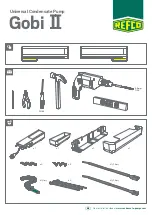
SECTION 7: V
ENTING
11 of 59
SECTION 7: VENTING
WARNING
Carbon Monoxide Hazard
Heaters may be installed
vented or unvented.
Vented heaters must be
vented outdoors.
Unvented heaters must be
installed according to the
installation manual.
Failure to follow these
instructions can result in
death or injury.
7.1 Venting
This heater must be vented in accordance with the
rules contained in this manual and with the following
national codes and any state, provincial or local
codes which may apply:
United States:
Refer to
NFPA 54/ANSI Z223.1 - latest revision, National
Fuel Gas Code;
Canada:
Refer to CSA B149.1
Natural Gas and Propane Installation Code.
Any portion of vent pipe passing through a
combustible wall must have a listed thimble to
conform with the above codes.
The heater may be installed unvented in
certain circumstances according to building
ventilation codes. Refer to the above codes
for further information.
Unvented operation also requires compliance with
the clearances to combustibles given
.
The bottom of the vent or air intake terminal shall not
be located less than 1' (.3 m) above grade level.
The vent shall not terminate less than 7' (2.1 m)
above grade where located adjacent to public
walkways.
Vent terminal must be installed at a height sufficient
to prevent blockage by snow and building materials
protected from degradation by flue gasses.
Vent terminal must be beyond any combustible
overhang.
Secure all joints with corrosion resistant #8 x 3/8"
sheet metal screws.
For single wall venting, pressure sensitive aluminum
tape or silicone sealant must be used to seal all
joints.
Aluminum tape shall have a minimum temperature
rating of 400° F (204° C) and meet SMACNA AFTS-
100-73 standards. High temperature silicone
sealant must have a minimum temperature rating of
480° F (250° C).
7.1.1 United States Requirements
Vent must terminate at least 3' (.9 m) above any
forced air inlet located within 10' (3.1 m).
Vent must terminate at least 4' (1.2 m) below,
4' (1.2 m) horizontally from, or 1' (.3 m) above any
door, operable window, or gravity air inlet into any
building.
NFPA 54/ANSI Z223.1 - latest revision, National
Fuel Gas Code specifies a 4' (1.2 m) horizontal vent
terminal clearance from gas and electric meters,
regulators and relief equipment.
7.1.2 Canadian Requirements
The vent shall not terminate within 6' (1.8 m) of a
mechanical air supply inlet to any building.
The vent shall not terminate within 3' (.9 m) of a
window or door that can be opened in any building,
any non-mechanical air supply inlet to any building,
or of the combustion air inlet of any other appliance.
7.2 Vent Installation
Maintain clearances to combustibles at all times for
safety. Clearances are the required distances that
combustible objects must be away from the heater
to prevent serious fire hazard.
.
For vented units, the vent must terminate outside of
the building.
Vents must be fully sealed and correctly sized for
the model. If the vent passes through a wall or
ceiling of combustible material, it must be enclosed
by a listed thimble and be separated from the
thimble by at least a 2" (5 cm) air gap.
For separated combustion models, vents and air
intakes must be a fully sealed system and correctly
sized for the model. Vent should be assembled as
detailed
. The joints between the vent terminal and
the roof or wall must be properly sealed. If the vent
passes through a wall or ceiling of combustible
material, it must be enclosed by a listed thimble and
be separated from the thimble by at least a 2" (5 cm)
air gap.
Vents and air intakes must be adequately
supported so that the heater does not bear the
weight of the pipes.
For vent termination
.
Summary of Contents for UHAS 150
Page 2: ......
Page 4: ......
Page 8: ......
Page 48: ...UHA STANDARD UNIT HEATER INSTALLATION OPERATION AND SERVICE MANUAL 40 of 59 14 1 General...
Page 68: ...UHA STANDARD UNIT HEATER INSTALLATION OPERATION AND SERVICE MANUAL 60 of 59...
Page 70: ......
Page 71: ......
Page 72: ......
Page 73: ......
Page 74: ......
















































